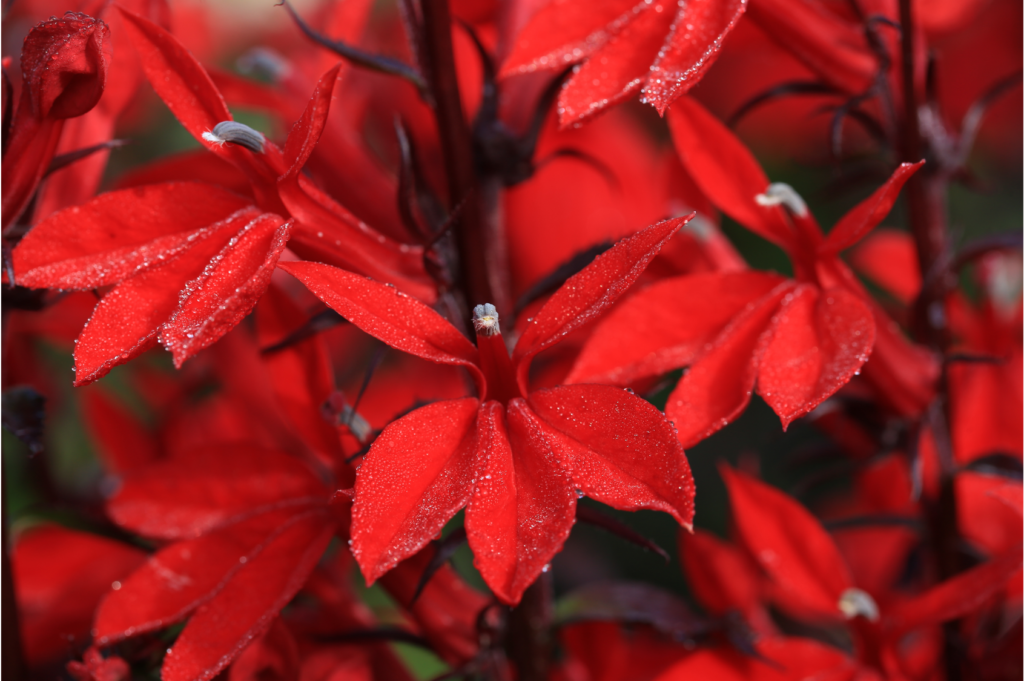By Kathy Abascal
Lobelia is a lovely plant with a gorgeous flower. There are many lobelia species, ranging from the blue L. sylphatica, to the widely used, white-flowered L. inflata, to my favorite L. cardinalis with its dark red flowers. All lobelias (except nursery hybrids) are medicinal. Although it took me quite some time to get over my fear of using this plant, I now make sure I always have some on hand.
Most lobelias are native to North America and were used by indigenous peoples to treat respiratory issues, muscle spasms, and as a purgative. L. inflata continues to be known as Indian tobacco, a clear reference to its use in traditional medicine. There is also a species of lobelia found in China that is considered one of their 50 fundamental (or “top” herbs).
Lobelia is a “low dose” or “drop dose” plant. That is, one only needs a few drops (5-20) of the tincture to gain its benefit. At higher doses, whether as a tea, capsule, or tincture, Lobelia is nauseating and will make you vomit.
Back in the 1800s, purging was a central part of many medical treatments. Perhaps because food and water often were contaminated, and vomiting helped the body rid itself of toxins. Perhaps because, when the respiratory tract is filled with thick, sticky mucus, vomiting can help: As we become nauseated, we salivate, our eyes and noses run, and we drool. Rather unpleasant, but at the same time, the phlegm stuck in the bronchi also loosens up, easing breathing and expectoration.
Finally, purges were popular simply because they were “heroic,” especially among traditional physicians of that era. Heroic measures like purgatives, enemas, blistering, along with toxic doses of mercury, were considered a prerequisite of any healing. In the process of being used as a heroic purgative, lobelia’s reputation was tarnished. Even today, lobelia continues to be viewed with fear and excessive caution because it was once prescribed in large purgative doses, followed by prolonged sweats. This, of course, tended to weaken rather than heal the sick.
In contrast, the Eclectic physicians (a small group of non-traditional physicians in the 1800s) used medicinal herbs rather than heroic measures. This group did not use lobelia as a purgative. Instead, they used drop doses of the plant as an anti-spasmodic. In an age where inhalers were unavailable, they might prescribe a couple puffs of the smoke of lobelia to stop suffocating spasms of asthma attacks. In small doses, lobelia relieved the excruciating pain of kidney stones, allowing many to pass. Lobelia relieved the spasms of croup and the whooping cough.
Finally, lobelia was considered one of the most important medicines in epidemic influenza. It eased the non-productive, dry, barking, hacking cough that often follows the flu. It opened the respiratory passages in patients who developed pneumonia secondary to the flu. In many cases of the flu, the plant was used as a chest rub to prevent pneumonia from moving into the lungs via respiratory tissue damaged by the flu virus.
I gathered lobelia on field trips while studying with the late Michael Moore in Arizona. Michael had a great fondness for the plant as it had helped him pass several kidney stones over the years without the aid of modern pain relievers (which he abhorred). Nonetheless, many years passed before I tried lobelia. I was troubled by its reputation as a dangerous purgative, despite all the information I had on its many benefits.
Then, one day, I came down with the flu. I was in bed, in agony. My muscles ached. My head ached. And my chest felt like it was in a vise. My old stand-by flu herbs (boneset and pleurisy root) were not doing enough to ease my symptoms, so I finally decided to try some lobelia. I took 5 drops of my tincture, and almost instantly the vise grip around my chest loosened and I fell asleep. I woke a few hours later, feeling as awful as I had before I took the lobelia. I took another dose and again fell back sleep. This continued through the night with longer and longer periods of sleep until I finally woke feeling human again. Thanks to lobelia, my bout with the flu was much less painful and helped me heal more quickly. I became a fan of the plant.
These days, I always have lobelia on hand. As we enter into the season of respiratory viruses, you may want to have and be able to use small doses of the tincture to relax respiratory spasms, coughs, and the achiness, should you have the misfortune of catching a bad case of the flu.

